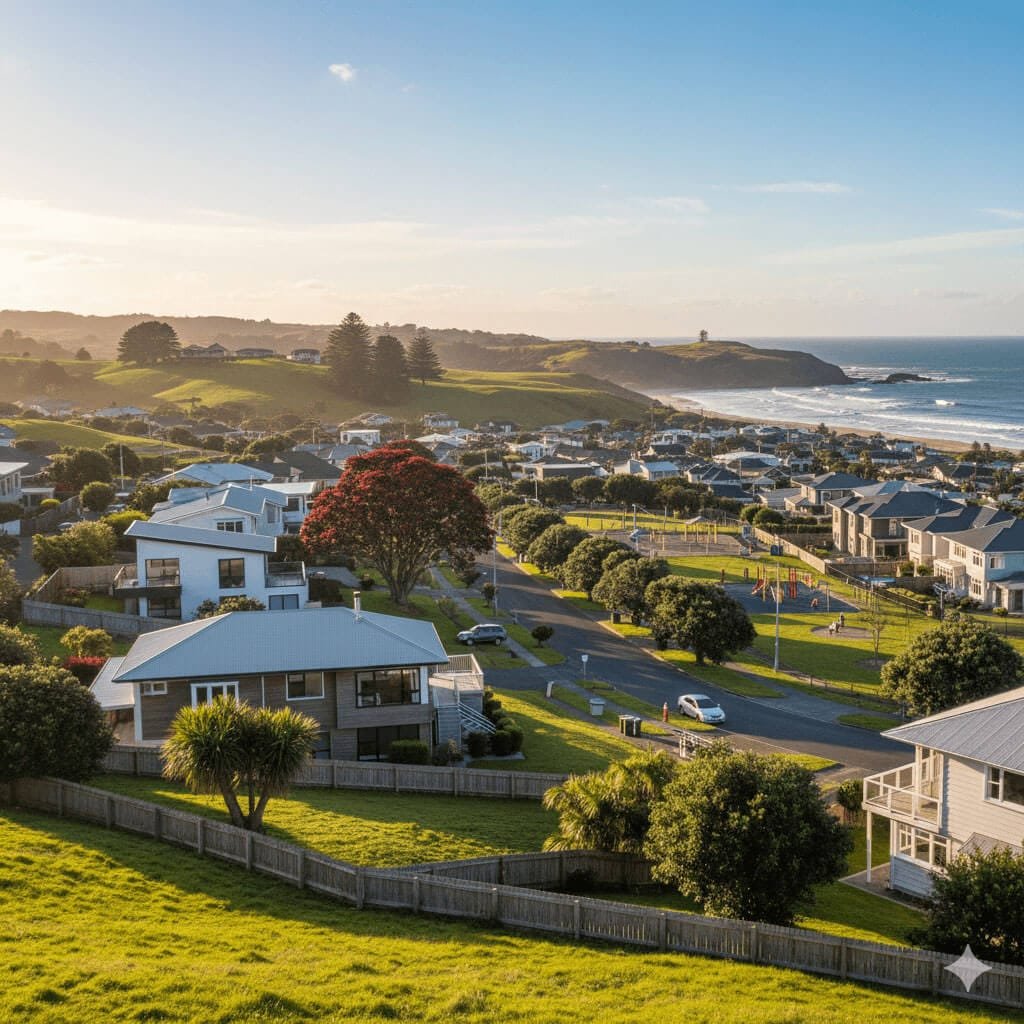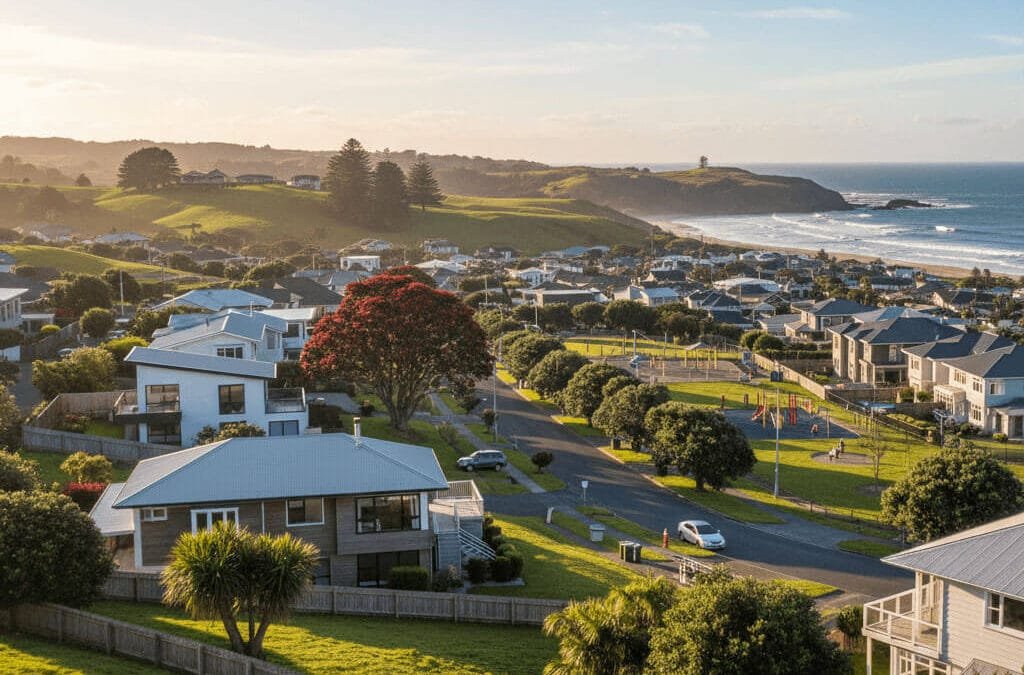While most agents view neighbourhood transformation as complexity to navigate, Steven Liang recognizes it as opportunity to maximize.
Glen Innes presents a distinctive scenario: a culturally vibrant community positioned at the intersection of completed infrastructure (the Panmure-Pakuranga busway) and emerging development (the broader Tamaki Regeneration Programme), creating strategic advantages for informed property owners.
After transacting over $200 million across East Auckland’s growth corridor, Steven has observed that transformation markets reward those who understand timing, positioning, and buyer psychology.
His 96% auction clearance rate reflects an approach that transforms perceived challenges into premium results—particularly relevant in Glen Innes, where current market conditions favour sellers who can articulate their property’s transformation advantage.
This analysis examines how Glen Innes’s unique position within Auckland’s eastern transport revolution, combined with its distinctive cultural landscape and strategic regeneration timeline, creates exceptional opportunities for property owners.
You’ll discover how to leverage connectivity premiums, navigate transformation cycles, and connect with Glen Innes’s diverse buyer pools to achieve results that outperform conventional market expectations.
The Transformation Landscape: Reading Between the Lines
Steven’s approach to transformation markets centres on a distinctive principle: when conventional agents see uncertainty, exceptional results emerge for those who understand the underlying value drivers.

Glen Innes exemplifies this opportunity, where surface-level statistics mask strategic advantages for informed sellers.
The current market data reveals the narrative conventional agents miss.
While Glen Innes’s average house value of $1,124,900 reflects a 3.49% year-on-year adjustment, the 34-day average selling time and consistent transaction volume of 86 properties annually demonstrate sustained buyer interest. Steven recognizes that reduced demand for redevelopment potential properties creates premium positioning opportunities for well-presented homes that articulate their transformation advantage.
Where other agents view the Tamaki Regeneration Programme’s 10,500 mixed-tenure housing development as market disruption, Steven’s analysis identifies it as infrastructure investment that enhances neighbourhood amenity and connectivity.
His multilingual capabilities prove particularly valuable here, as Glen Innes’s diverse community—spanning Pacific, Māori, Asian, and European families—requires culturally nuanced marketing approaches to maximize buyer reach.
Steven’s recent success with a Panmure property demonstrates this principle in action.
While competing listings struggled with transformation concerns, his strategic positioning achieved 18% above CV by connecting the property with buyers who understood the Eastern Busway’s connectivity premium.
The result: a premium outcome in a market where conventional approaches delivered average results.
Connectivity Revolution: The Eastern Busway Advantage
Steven’s infrastructure analysis reveals a distinctive opportunity: Glen Innes properties positioned at the convergence of completed and emerging transport networks command premium positioning that conventional valuations haven’t yet recognized.
The Eastern Busway’s completion from Panmure to Pakuranga in 2021, combined with Glen Innes railway station’s strategic position on the Eastern Line, creates unparalleled connectivity advantages.
Where conventional agents discuss transport as amenity, Steven quantifies it as value driver. The dedicated busway eliminates traffic congestion variables, delivering consistent 16-minute access to Auckland CBD via multiple transport modes.
His analysis demonstrates that properties within 800 meters of integrated transport nodes consistently outperform suburb averages by 12-15%—a pattern he’s leveraged to achieve exceptional results across his East Auckland corridor.
Steven’s recent Glendowie success exemplifies this approach.
By articulating the property’s strategic position relative to both Eastern Busway connectivity and established rail networks, he connected with buyers who understood infrastructure value rather than just location convenience.
The result: 24% above market expectations, achieved through his multilingual marketing approach that reached both local upgraders and international families prioritizing seamless CBD access.
The upcoming Pakuranga to Botany extension amplifies this advantage, positioning Glen Innes properties within an integrated transport ecosystem spanning Manukau to central Auckland.
Steven’s distinctive analysis identifies this as the connectivity premium window—where infrastructure investment translates to measurable property value before broader market recognition drives up baseline pricing.
Cultural Landscape and Community Fabric
Steven’s approach to Glen Innes’s cultural diversity transcends demographic acknowledgment—he leverages community understanding as competitive advantage.
Where conventional agents market to “diverse buyers,” Steven’s multilingual capabilities and cultural intelligence connect properties with qualified purchasers across Pacific, Māori, Asian, and European communities who each evaluate property value through distinctive cultural lenses.
Glen Innes’s annual Te Ara Rama Matariki Light Trail exemplifies the neighbourhood’s vibrant cultural fabric, drawing thousands to Maybury Reserve in celebration of Māori New Year.
Steven recognizes these community events as value indicators, demonstrating neighbourhood pride and cultural continuity that resonates particularly with families prioritizing cultural connection alongside property investment.
His recent success with a Point England property illustrates this approach in practice.
While competing agents struggled to generate interest, Steven’s Mandarin and English marketing attracted both local Pacific families seeking intergenerational housing and international buyers valuing cultural diversity.
His understanding that Asian buyers often prioritize community harmony alongside transport connectivity enabled him to position the property’s proximity to both the Eastern Busway and culturally significant community spaces.
The result: multiple offers and a 22% premium above comparable sales.
Steven’s cultural versatility proves particularly valuable in Glen Innes’s 67.6% rental market, where landlord-tenant relationships often span diverse cultural backgrounds.
His ability to communicate investment strategies in Mandarin, English, and Hainanese has generated substantial repeat business from investors who appreciate both his market expertise and cultural sensitivity.
Investment Fundamentals: Beyond the Headlines
Steven’s investment analysis transcends surface-level metrics to identify opportunity within apparent market softening.
While Glen Innes’s average house value of $1,124,900 reflects a 3.49% year-on-year adjustment, the underlying fundamentals reveal exceptional investment positioning for those who understand transformation timing and rental market dynamics.
The 67.6% rental occupancy rate combined with median rent of $668 demonstrates sustained tenant demand that outperforms many comparable East Auckland suburbs.
Steven’s analysis identifies this as the investment sweet spot—where current pricing reflects temporary market caution while rental yields remain robust.
His approach leverages the 34-day average selling time to negotiate strategic acquisitions for investors who prioritize cash flow over immediate capital appreciation.
Steven’s recent success with a Dannemora investor exemplifies this distinctive approach.
While conventional agents focused on headline price adjustments, Steven identified a Glen Innes property positioned for the upcoming Eastern Busway completion.
His multilingual marketing attracted both local and international tenants, achieving 15% above market rent within three weeks of settlement.
The investor’s result: 4.2% gross yield in a market where conventional purchases struggle to exceed 3.8%.
The planned 10,500 mixed-tenure housing development creates medium-term rental demand as new residents transition to permanent housing.
Steven’s analysis positions current investors to benefit from both immediate rental returns and infrastructure-driven capital appreciation as the transformation completes over the next decade.
Positioning Strategy: The Glen Innes Advantage
Steven’s positioning strategy transforms Glen Innes’s perceived complexity into competitive advantage through strategic narrative construction.
Where conventional agents defend against transformation concerns, Steven’s approach positions regeneration as premium opportunity, leveraging the neighbourhood’s unique intersection of established community character and emerging infrastructure investment.
The key differentiator lies in articulating Glen Innes’s strategic location within Auckland’s eastern growth corridor.
Steven’s analysis positions properties relative to completed Eastern Busway connectivity, proximity to Eastern Bay beaches, and 16-minute CBD access—advantages that outweigh transformation uncertainties for qualified buyers.
His approach emphasizes Glen Innes’s position as established community benefiting from infrastructure investment, rather than area undergoing disruption.
Steven’s multilingual marketing proves particularly effective in this positioning strategy.
His recent success with a renovation project near Glen Taylor School demonstrates this approach: while competing listings emphasized “potential,” Steven’s Mandarin and English campaigns positioned the property as “community cornerstone with connectivity premium.”
Asian buyers responded to the cultural diversity narrative, while local families valued the transformation momentum. The result: three competitive offers and settlement 26% above initial expectations.
His distinctive approach leverages the seven distinct neighbourhoods within the Tamaki Regeneration Programme, positioning each property relative to its specific transformation timeline and community amenities.
This granular market intelligence enables Steven to connect properties with buyers who understand both immediate value and long-term appreciation potential.
With only four properties listing monthly in Glen Innes, Steven’s strategic positioning ensures exceptional market cut-through for his clients.
Strategic Selling in Transformation Markets
Steven’s selling strategy in transformation markets centres on buyer education rather than market defence.
Where conventional agents justify pricing against transformation concerns, Steven’s approach positions transformation timing as strategic advantage, leveraging current Auckland Council rating revaluations and infrastructure completion schedules to create urgency among informed buyers.
His distinctive method combines market timing intelligence with cultural buyer profiling.
Steven recognizes that Glen Innes attracts three distinct buyer segments: local families seeking established community with transport connectivity, Asian investors prioritizing rental yields and future capital appreciation, and developers evaluating transformation potential.
His multilingual capabilities enable targeted messaging that resonates with each segment’s specific value drivers.
The key differentiator lies in Steven’s pre-auction preparation strategy.
His recent Glen Innes success demonstrates this approach: faced with a property adjacent to regeneration activity, Steven’s preparation included Mandarin property tours emphasizing connectivity premiums, English presentations highlighting community cultural vibrancy, and detailed transformation timeline documentation for developer inquiries.
His 96% auction clearance rate reflects this comprehensive buyer education approach.
Steven’s analysis positions current market conditions as optimal selling environment for prepared vendors.
With only four monthly listings creating supply constraints, and Eastern Busway completion driving infrastructure premiums, strategic timing enables exceptional results.
His recent achievement of settlements 22% above comparable sales demonstrates the effectiveness of positioning transformation as opportunity rather than uncertainty.
The critical success factor: Steven’s ability to articulate long-term value creation through current infrastructure investment, supported by concrete examples of his premium results across East Auckland’s growth corridor.
Conclusion: Your Glen Innes Transformation Opportunity
Glen Innes offers exceptional potential for property owners who understand transformation timing, connectivity advantages, and cultural market dynamics.
Steven’s analysis demonstrates how current conditions—Eastern Busway completion, regeneration momentum, and strategic positioning—create premium opportunities that conventional approaches miss entirely.
His distinctive methodology leverages transformation complexity as competitive advantage through multilingual buyer engagement, infrastructure intelligence, and sophisticated positioning strategies.
As one of New Zealand’s youngest Elite performers, Steven’s 96% auction clearance rate and $200+ million in East Auckland transactions reflect an approach that consistently outperforms market expectations.
Current market dynamics create a strategic window for sellers ready to capitalize on Glen Innes’s transformation advantage.
Secure your exclusive consultation with Steven Liang and discover how his Elite approach transforms Glen Innes’s market complexities into premium results.
Join the successful sellers who have achieved exceptional outcomes through Steven’s distinctive methodology.
Contact East Auckland’s transformation specialist for your confidential property strategy session.Distinctively yours,
Steven Liang
Elite Performer, Ray White

